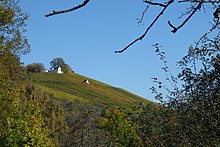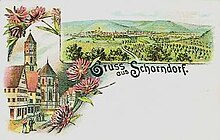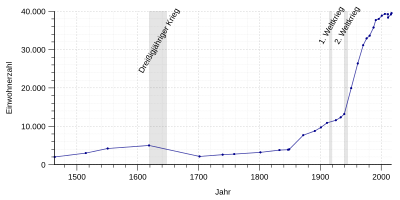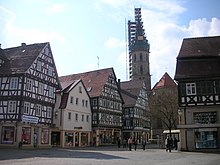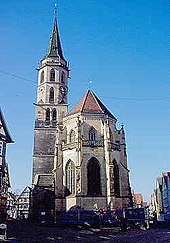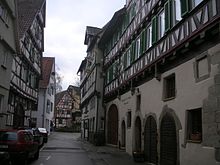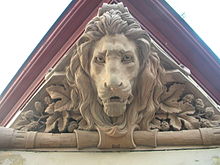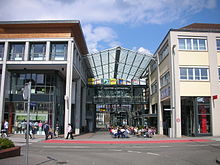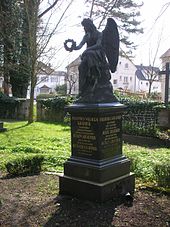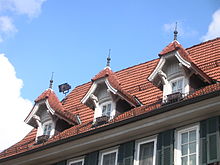Schorndorf
| coat of arms | Germany map | |
|---|---|---|
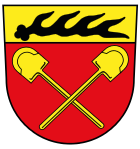
|
Coordinates: 48 ° 48 ' N , 9 ° 32' E |
|
| Basic data | ||
| State : | Baden-Württemberg | |
| Administrative region : | Stuttgart | |
| County : | Rems-Murr district | |
| Height : | 256 m above sea level NHN | |
| Area : | 56.83 km 2 | |
| Residents: | 39,634 (Dec. 31, 2018) | |
| Population density : | 697 inhabitants per km 2 | |
| Postal code : | 73614 | |
| Area code : | 07181 | |
| License plate : | WN, BK | |
| Community key : | 08 1 19 067 | |
| LOCODE : | DE SDF | |
| City structure: | Core city and 7 districts | |
City administration address : |
Marktplatz 1 73614 Schorndorf |
|
| Website : | ||
| Lord Mayor : | Matthias Klopfer ( SPD ) | |
| Location of the town of Schorndorf in the Rems-Murr district | ||
Schorndorf is a town in Baden-Württemberg , about 26 kilometers east of Stuttgart . It belongs to the Stuttgart region (until 1992 the Middle Neckar region ) and the European metropolitan region of Stuttgart . After Waiblingen and Fellbach, it is the third largest city in the Rems-Murr district and a central center for the surrounding communities.
Schorndorf has been a major district town since January 1, 1967 . The city of Schorndorf has agreed an administrative partnership with the municipality of Winterbach .
geography
Geographical location
Schorndorf lies in a deep valley widening of the Rems , which is bordered in the south by the Schurwald and in the north by the mountains and the Welzheimer forest . In the urban area, the small rivers Schornbach and Wieslauf, coming from the north, flow into the Rems . This flows through the city center from east to west. The old town of Schorndorf is located south of the river.
Neighboring communities
The following towns and communities border the town of Schorndorf; they are called clockwise starting in the west:
Winterbach , Remshalden , Berglen , Rudersberg , Welzheim , Urbach , Plüderhausen (all Rems-Murr district ), Adelberg , Wangen and Uhingen (all district Göppingen ) and Lichtenwald ( district Esslingen ).
City structure
Schorndorf consists of the core town and the seven districts of Buhlbronn , Haubersbronn , Miedelsbach , Oberberken , Schlichten , Schornbach and Weiler / Rems, which were incorporated as part of the regional reform of the 1970s . Some of the districts still have separate residential areas with a special name, Metzlinsweiler Hof zu Buhlbronn, Metzlinsweiler Mühle zu Haubersbronn, Unterberken zu Oberberken and Mannshaupten zu Schornbach.
In the core city, further residential areas with their own names are sometimes distinguished, the names of which have emerged in the course of history due to the development, but are usually not exactly delimitable. These include, for example, Fuchshof and Grauhalde.
The districts apart from the core city each form a village with a local council in the sense of the Baden-Württemberg municipal code .
| District / town | Number of local councils | population |
|---|---|---|
| Core city | - | 24,716 |
| Buhlbronn | 8th | 777 |
| Haubersbronn | 14th | 3,299 |
| Miedelsbach | 12 | 2,077 |
| Oberberken with Unterberken | 10 | 1,554 |
| Finishing | 8th | 853 |
| Schornbach with heads of men | 10 | 1,825 |
| hamlet | 14th | 4.151 |
As of the figures: core town December 31, 2007, hamlet January 31, 2009, all others January 31, 2008.
Division of space

According to data from the State Statistical Office , as of 2014.
Spatial planning
Schorndorf is a medium-sized center within the Stuttgart region , the regional center of which is Stuttgart. The south and east of the Rems-Murr district belong to the central area of Schorndorf, i. H. the Rems- and Wieslauftal as well as adjacent areas. In addition to Schorndorf, these are the towns and communities of Alfdorf, Kaisersbach, Plüderhausen, Remshalden, Rudersberg, Urbach, Welzheim and Winterbach.
history
prehistory
The earliest traces of settlement in the Schorndorf area can be found as early as the Mesolithic and much more frequently for the Neolithic . In contrast, there are hardly any documented finds for settlement activity during the Metal Age ( Copper , Bronze and Iron Ages ).
Roman times
Archaeological finds from Roman times are known to a large extent. Under Emperor Antoninus Pius , from the middle of the 2nd century AD, the Limes was "brought forward" and had reached its extreme position ( Front Limes ).
The border of the Roman Empire shifted from the Neckar-Odenwald line to the east. The result was the new section of the Upper German Limes , which ran as a dead straight line from Fort Lorch to Fort Miltenberg am Main. At the same time was Donaulimes or upstream Alblimes moved to the north and created the new section of the Raetian Limes from the castle Lorch to the fort Eining , where he met shortly before Regensburg back to the Danube limes. By moving the Limes forward, the Remstal was included in the provinces of Upper Germany ( Germania superior ) and Raetia . The border between these two Roman provinces ran east of Lorch Fort.
In the course of the relocation of the Limes, new trunk roads were built or existing pre-Roman road connections expanded, in particular to connect the Cannstatt Fort with the Welzheim and Aalen Fortresses . In the area of today's town of Schorndorf, several connecting roads met these streets in Roman times, the exact course of which is known only approximately.
In Schorndorf there was presumably a crossroad where an extensive street vicus developed. This could be proven on the northern edge of today's Schorndorf city area with the help of numerous archaeological sites. Other individual finds are a Roman villa rustica in Gewann Schornbacher Strasse, a stone flat screen of Maja and Merkur in Grafenhalde and a stone image of Merkur in Ramsbach.
Recently, however, revaluations of finds that have been stored in the city museum since the 1950s ( Viergöttersteine ) have led to the assumption that in the area of today's Schorndorfer Nordstadt there “could have been a large Roman settlement” and not just a street vicus .
Early middle ages
A little to the west of the Roman site around 1955, during construction work on Christallerweg, scattered grave goods and Alemannic graves were found, some of which were deepened in the Roman cultural layer. The chronological classification of the objects covers a period from the middle of the 6th century to the time around 700. Although there are only a few finds, several finds are represented that can be described as individual items in southwest Germany and therefore from are of particular archaeological interest. In many cases, these are items that could indicate an elevated position of the deceased, which requires a socially differentiated, larger population group that has populated the area over several generations. A settlement belonging to the graves must have been in the area, but could not be proven by other finds. This early medieval settlement north of the Rems, which is not localized, was probably abandoned in the first half of the 8th century at the latest. The reason was assumed to be the risk of flooding due to the Rems flooding. From the fact that there are no settlements with the ending -ingen or -heim in the middle Rems Valley, research has so far assumed that the early medieval settlement in this region did not begin until after the Frankish expansion of rule. In previous research, Schorndorf was viewed as a settlement of the so-called older state development, which in this region is dated between the 7th and 9th centuries. Such a temporal approach is now corrected by the finds on Christallerweg, which date back to the 6th century.
In the 8th century, on flood-proof terrain south of the Rems, on an alluvial sand cone in the area of today's town church, a new village settlement "uff dem Sand" developed as the origin of the medieval Schorndorf. The patronage of the church, which was consecrated to Saints Basilides, Cyrinus, Nabor, Nazarius and Celsus, may indicate a date. This suggests that the church was founded in the period after AD 765.
middle Ages
The first written mention of the place name comes from the year 1235. In a document, according to which a Heinrich von Waldhausen and his wife transferred properties in Urbach and Hülben to the Lorch monastery in exchange for two lifelong benefices , a “Dietericus de Shorendorf” is a witness among others “Listed. The same appears as "Dieterico de Sordorf" in another document of the Adelberg monastery from 1236 again as a witness. This time he is referred to as "ministerialis imperii", ie as a (Staufer) Reich servant . The predecessor building of today's castle is assumed to be the official seat (Ministerialenburg).
In the years that followed, Count Ulrich I von Württemberg (Ulrich the founder) used the grueling disputes between Frederick II and the Pope and the Upper Italian City Association , which caused the Staufen family to weaken and strengthen and expand his own household power. The place Schorndorf was probably acquired or annexed by Ulrich around 1250, although the exact circumstances are not known. The first urban settlement emerged under Count Ulrich following the Ministerialenburg. The first documented mention as a town in Württemberg comes from the year 1262, when Ulrich allowed the Adelberg Monastery to pass duty-free through his town of Schorndorf ("municipium nostrum Schorndorf") and its entire area. The city was expanded and fortified in order to secure the Württemberg rule against the remaining Staufer possessions in the east. The first mention of the court in Schorndorf ("judices iurati") and the earliest mention of city walls ("muros opidi") date from 1299, although the walls initially only included the part of today's old town between the market square and the castle. The western village "uff dem Sand" remained outside the walls as a suburb. Only in the course of the 14th century was the suburb with church and churchyard included in the walling. Between this so-called lower town and the eastern, so-called upper town, the still existing moat was filled in and the market square was created in the course of the 14th and 15th centuries.
The county of Württemberg pursued an aggressive expansion policy for several generations and repeatedly came into conflict with the empire and the imperial cities that opposed this expansion. The Schorndorf Fortress represented the entrance gate to Württemberg from the east and was therefore the scene of meetings and disputes several times.
During the Imperial War (1311-1312), which Emperor Heinrich VII led together with several imperial cities against Count Eberhard the Illustrious from Württemberg , he lost almost all of his land. Schorndorf was also besieged, conquered and handed over to the imperial city of Esslingen , which was a main enemy of Count Eberhard during the war. Only the death of the emperor and the political situation after the king's election in 1314 with Ludwig IV as king and Frederick the fair as the opposing king prevented the total defeat of Württemberg. Eberhard I then cleverly tacted between king and counter-king, so that he could not only compensate for the territorial losses, but also gain additional areas, and Schorndorf also came back to Württemberg.
In 1316 King Ludwig camped in front of the Schorndorf walls, without attacking the city, on his way to Esslingen, where he met his cousin and rival Friedrich the Beautiful in a battle.
Eberhard's son and successor, Count Ulrich III. von Württemberg, managed to get along with both kings without open conflicts through diplomatic skills. After the death of Friedrich he received the Reich Office of the Lower Swabian Governor from Ludwig. The resulting political weight at the imperial level, his regional alliance policy and the marriage property and legacy of his wife enabled the prudent Ulrich to significantly enlarge the Württemberg territory during his reign without fighting. In 1336 he was given the prestigious office of pioneer and imperial ensign from Ludwig, who has now been crowned emperor, and also known as Ludwig the Bavarian . During this time, the Schorndorf Fortress was spared fighting.
In August 1347 Ludwig IV stayed in Schorndorf again, this time with peaceful intent. A few months later, in December 1347, his successor, King Charles IV, was received in the city. Both issued a number of documents in Schorndorf, which underlines the importance of the city.
Under the reign of Ulrich III's sons, Count Eberhard II (Greiner) and his initially co-ruling brother Ulrich IV , the disputes between Württemberg and the imperial cities and the empire flared up again. The two count brothers abused the power they possessed through the office of governor conferred on them by the emperor, and suppressed the imperial cities in their district. Because of these attacks and because of their refusal to support his peace policy, Charles IV felt compelled, with the support of the imperial cities, to raise an imperial army against Württemberg. The emperor marched into the Rems valley via Aalen and a warlike conflict broke out near Schorndorf (Battle of Schorndorf in 1360). After an initially undecided course, the fresh supply forces that Karl had at his disposal were decisive. The two count brothers withdrew to the Schorndorf fortress, which was besieged by the emperor. A few days after Karl had the surrounding area devastated, the Württemberg counts finally gave up and submitted to the emperor. At the mediation of the bishops of Speyer, Augsburg and Constance a peace agreement was reached, whereby Karl contented himself with very moderate peace conditions.
Eberhard den Greiner was followed by his grandson Count Eberhard III at the head of the House of Württemberg . (the mildness) . His reign was characterized by a peace-keeping policy of alliances with the neighboring royal houses and imperial cities. This also gave Schorndorf a quieter time without major fighting. After the death of Eberhard III. (* 1362; † 1417) Schorndorf served his widow Elisabeth, b. Countess of Nuremberg, as a widow's seat, where she passed away in 1430, heavily in debt.
In 1431 the city hosted the king and later emperor Sigismund and the papal legate, Cardinal Julian.
Under the count brothers Ludwig I and Ulrich V , the country was divided in 1441, which was recorded on April 23, 1441. Ulrich received the eastern and northern part of the country with the residential city of Stuttgart, Ludwig the western and southern part of the country with the residential city of Urach. Schorndorf thus belonged to Württemberg-Stuttgart in the future. The division, which was originally limited to four years, was established as an unlimited division on January 25, 1442 by the Nürtingen Treaty .
On July 6, 1446, Ludwig I and Ulrich V joined Archbishop Dietrich von Mainz , Count Palatine Ludwig IV , Duke Albrecht VI. Austria and other princes in Schorndorf formed an alliance for two years to prevent the robberies in their lands.
When Count Ulrich V of Württemberg married Margarethe von Savoyen , widow of Count Palatine Ludwig IV., On July 9, 1449 , he committed her to the income of the city and the office of Schorndorf "and let her pay homage to her there" for her rich contribution. The fact that Margarethe actually ruled the town and office of Schorndorf as the actual mistress was shown by the fact that in 1454 she assigned the village of Weiler near Schorndorf to a certain Konrad von Lomersheim for his lifetime.
With the Münsinger Treaty of 1482 and the Esslingen Treaty of 1492, Count Eberhard im Bart (Württemberg-Urach) and Eberhard VI. (Württemberg-Stuttgart) cancel the division of the country again. The indivisibility of the state and the primogeniture (birthright) in Württemberg were made legally binding, creating an important prerequisite for the later elevation of Württemberg to a duchy . From 1495 Schorndorf became part of the newly created Duchy of Württemberg .
16th and 17th centuries


In 1634 the city burned down almost completely after the occupation by imperial troops under Walter Butler . In 1688, the women of Schorndorf, led by Anna Barbara Walch (later Künkelin), prevented the fortress from being handed over to French troops under General Mélac .
18th and 19th centuries
In 1759, the office of Schorndorf was elevated to a higher office. In 1806, when the Kingdom of Württemberg was established, the Oberamt Schorndorf was reduced in size as part of a reorganization by transferring some communities to the neighboring offices. Gottlieb Daimler , the inventor of the first high-speed light gasoline engine, was born on March 17, 1834 in Höllgasse. The Remstalbahn was opened in 1861, making Schorndorf a station in the Württemberg railway network .
20th century
With the reorganization of the district in Württemberg during the Nazi era , the Oberamt Schorndorf was dissolved in 1938 . The entire Schorndorf area came to the Waiblingen district .
During the Nazi era , political opponents were persecuted locally. They included the social democratic city councilor Gottlob Kamm , who was interned in the Oberer Kuhberg concentration camp , and the SPD local chairman and union official Heinrich Talmon Groß , who lost his life in the Mauthausen concentration camp in 1945 . The city honors her memory with street names.
Since autumn 1943, the castle castle has housed a department of the Stapo control center in Stuttgart responsible for the political and police defense and the control of V-persons . The Gestapo library was also brought there to safety.
In the last months of the Second World War , the Schorndorfer section of the Remsbahn was repeatedly the target of Allied bombardments , which aimed to make this important railway line unusable. At Schorndorf there was also an American low- flying attack on a passenger train heading for Stuttgart during this time , killing both the locomotive driver and the stoker .
Shortly before the end of the war in 1945, American troops stood at the gates of Schorndorf, while the local armed forces associations were determined to defend the city. Ultimately, however, Walter Arnold , who later became an honorary citizen, succeeded in handing the city over to the Americans without a fight, which spared Schorndorf's historic building from fighting and has been preserved to this day.
In 1945 Schorndorf became part of the American zone of occupation and thus belonged to the newly founded state of Württemberg-Baden , which was incorporated into the current state of Baden-Württemberg in 1952.
The population of Schorndorf exceeded the 20,000 mark in 1963. Thereupon the city administration submitted the application to be elevated to a major district town , which the state government of Baden-Württemberg decided with effect from January 1, 1967.
In the years from 1972 to 1975 seven surrounding communities were incorporated and with the district reform in Baden-Württemberg on January 1, 1973, Schorndorf became the new Rems-Murr district.
21st century
In 2005, the Baden-Württemberg Home Days took place in Schorndorf .
In 2019 Schorndorf was one of the 16 participating cities and communities in the Remstal, which took part in the "Remstal Green Project". Each participating municipality contributed a sculpture or a building. The sculpture “Prisma” was installed in Schorndorf. In addition, streets and parks were decorated.
Incorporations
The following communities were incorporated into the city of Schorndorf:
- January 1, 1972: Buhlbronn
- January 1, 1973: Miedelsbach, Schlichten and Weiler / Rems (until July 16, 1964 only hamlets)
- January 1, 1975: Haubersbronn, Oberberken with Unterberken and Schornbach with heads of men
Coats of arms of the former municipalities
 Buhlbronn |
 Haubersbronn |
 Miedelsbach |
 Oberberken |
 Finishing |
 Schornbach |
 Hamlet / Rems |
Population development
The figures before 1871 come from various sources and are in some cases to be regarded as estimates. They relate solely to the core city.
From 1871 the numbers come from censuses (VZ) or from official updates of the respective statistical offices (F). In 2011, a census (Ze) was not carried out , rather than a census (based on a sample).
The figures only relate to people with their main residence in Schorndorf.
|
|
religion
Schorndorf initially belonged to the diocese of Constance and was assigned to the archdeaconate ante nemus (Black Forest). As a result of belonging to the Duchy of Württemberg, the Reformation was introduced from 1534, as in the rest of Württemberg . After that Schorndorf was a predominantly Protestant town for many centuries. It soon became the seat of a deanery (see Schorndorf church district ) within the Evangelical Church in Württemberg . Originally there was only the town parish of Schorndorf, to which several chapels belonged in addition to the parish church. When the congregation grew strongly due to immigration, the Pauluskirche congregation (church from 1966) and the Reconciliation congregation (church from around 1995) were separated in 1971.
All three parishes continue to form the overall Evangelical parish of Schorndorf. The current districts of Schorndorf used to belong to Württemberg and are therefore predominantly Protestant. The parishioners of Buhlbronn initially belonged to the Buoch parish, then to Oppelsbohm and since 1890 to the Schornbach parish, which became its own parish early on, but since 1971 Buhlbronn has had its own church, the Friedenskirche. Haubersbronn forms its own parish. Miedelsbach first belonged to Lorch, then to Oberurbach, partly also to Haubersbronn, from 1807 to 1989 to the neighboring parish of Steinenberg (parish of Rudersberg ), and has been an independent parish since 1989, which has had its own church, the Christ Church, since 1967. Oberberken initially also belonged to Lorch, later to the parish Hundsholz and in 1859 the place became a separate parish together with Unterberken. For a long time, Schlichten was a branch of the Winterbach parish. In the 19th century it became its own parish administration and in 1859 an independent parish, which also looks after the neighboring town of Baiereck (city of Uhingen ). Weiler / Rems was a branch of Schorndorf for a long time, but became its own parish in 1852. All parishes in the town of Schorndorf belong to the Schorndorf deanery.
In the 19th century, Catholics moved to Schorndorf again. In 1907 the Catholic Church of St. Martin was built in Schorndorf and in 1917 Schorndorf became its own parish. In 1955 the new Holy Spirit Church was built, which was rebuilt in 1970. The old St. Martin Church has served as a chapel since then. The Schorndorf parish also includes the Catholics from Buhlbronn, Ober- / Unterberken, Schornbach and Haubersbronn, but Haubersbronn has had its own church, St. Bonifatius, since 1955. The Catholics from Miedelsbach belong to the parish Heiligste Dreifaltigkeit Rudersberg, those from Weiler / Rems belong to the parish Mariä Himmelfahrt Winterbach , but Weiler has had its own church St. Stephanus since 1966. All of the above-mentioned Catholic parishes belong to the Rems-Murr deanery of the Rottenburg-Stuttgart diocese .
In addition to the two large churches, there are also free churches in Schorndorf , including the United Methodist Church , the Evangelical Free Church Community ( Baptists ) and the Scala Christian Center of Volksmission Schorndorf e. V. The New Apostolic Church , Christian Science , the Seventh-day Adventists , the Christian Community and Jehovah's Witnesses are also represented in Schorndorf.
In May 2005 a mosque was inaugurated in the Hammerschlag industrial park .
politics
Municipal council
The local council in Schorndorf has 32 members. The local elections on May 26, 2019 led to the following final result. The municipal council consists of the elected voluntary councilors and the mayor as chairman. The mayor is entitled to vote in the municipal council.
| Parties and constituencies | % 2019 |
Seats 2019 |
% 2014 |
Seats 2014 |
Local elections 2019
% 30th 20th 10
0
27.30%
21.24%
18.37%
17.69%
9.38%
5.39%
0.64%
Gains and losses
|
|
|---|---|---|---|---|---|---|
| CDU | Christian Democratic Union of Germany | 27.30 | 8th | 31.86 | 10 | |
| SPD | Social Democratic Party of Germany | 21.24 | 7th | 28.51 | 9 | |
| Green | Alliance 90 / The Greens | 18.37 | 6th | 18.06 | 6th | |
| FDP-FW | Free Democratic Party - Free Voters | 17.69 | 6th | 21.58 | 7th | |
| AfD | Alternative for Germany | 9.38 | 3 | - | - | |
| GLS | Green List Schorndorf | 5.39 | 2 | - | - | |
| AUB | ALTERNATIVE INDEPENDENT CITIZENS | 0.64 | 0 | - | - | |
| total | 100.0 | 32 | 100.0 | 32 | ||
| voter turnout | 57.22% | 45.92% | ||||
mayor
At the top of the town of Schorndorf, “12 consules seu judices” were named in 1290, and since 1264 a “scultetus” was in charge. In the 14th century there was a bailiff , then a subordinate and a bailiff , who was in charge of the entire Schorndorf office. The offices of Waiblingen and Winnenden were subordinate to the Schorndorfer Obervogt until 1755. In the 15th century, a mayor also appeared as a representative of the court. Later there were four mayors and eight judges. Since 1819 the mayor has been called "Stadtschultheiß", since 1930 mayor, and when it was elevated to a major district town on January 1, 1967, the official title was mayor . This is elected directly by the electorate for eight years. He is chairman of the municipal council. His general deputies are the first alderman with the official title “First Mayor” and the second alderman with the official title “Mayor”.
City leaders since 1819:
- 1819–1821: Christian Rapp (* 1771; † 1853)
- 1821–1828: Gottlieb Friedrich von Stump (* 1791; † 1849)
- 1828–1845: Philipp Friedrich Palm (* 1759; † 1845)
- 1845–1866:
- 1866–1872: Johannes Frasch
- 1879–1903: Jakob Friz
- 1903–1905: Heinrich Beisswanger
- 1905–1933: Jakob Raible (7 May 1870 - 4 January 1949)
- 1933–1945: Richard Beeg (January 30, 1888 - October 22, 1945)
- 1945: Walter Arnold (born June 19, 1891 - † October 20, 1973)
- 1945–1948: Gottlob Kamm (SPD) (* October 21, 1897; † November 21, 1973)
- 1948–1954: Emil Hayer (born October 26, 1887; † November 22, 1977)
- 1954–1962: Franz Illenberger († July 22, 1974 - 72 years old)
- 1962–1982: Rudolf Bayler (born September 12, 1917; † September 3, 2007)
- 1982–1990: Reinhard Hanke (SPD) (born April 22, 1940)
- 1990-2006: Winfried Kübler (CDU) (born August 30, 1939)
- since 2006: Matthias Klopfer (SPD) (born March 14, 1968)
coat of arms
The coat of arms of the city of Schorndorf shows under a golden shield head, a lying black stag pole, in red two diagonally crossed golden spades with the leaf turned upwards (formerly: Schoren, hence Schorndorf). The city flag is yellow-red. Coat of arms and flags have been used for centuries.
Town twinning
The oldest of the Schorndorf town partnerships is that with the French prefecture of Tulle . It has existed since 1969 and formed the beginning of a number of other partnerships, which were only entered into in the 1990s: After reunification, the partnership agreement with the small town of Kahla in Thuringia was sealed in 1991 . The English Bury followed in 1994 and the American Tuscaloosa in 1996 . The most recent of the city-level twinnings was entered into in 1998 with the Italian Dueville . All Schorndorf town partnerships are supported by the Schorndorf e. V., which has existed since 1981. The most recent city partnership with the Basque city of Errenteria has officially existed since 2012.
-
 Tulle , France , since 1962
Tulle , France , since 1962 -
 Kahla , Thuringia , since 1991
Kahla , Thuringia , since 1991 -
 Bury , United Kingdom , since 1994
Bury , United Kingdom , since 1994 -
 Tuscaloosa , United States , since 1996
Tuscaloosa , United States , since 1996 -
 Dueville , Italy , since 1998
Dueville , Italy , since 1998 -
 Errenteria , Spain , since 2012
Errenteria , Spain , since 2012
The district of Weiler / Rems has maintained partnership relationships with the Austrian Radenthein since 1966:
-
 Radenthein , Austria , affirmed 2012
Radenthein , Austria , affirmed 2012
Economy and Infrastructure
traffic
The four-lane federal highway 29 Waiblingen– Nördlingen runs through the urban area of Schorndorf . It is developed as a bypass road and leads north around the core city. The next motorway junction is Aichelberg on the A 8 Stuttgart- Ulm .
The town of Schorndorf is known to many urban planners for its numerous roundabouts , as it has taken on a nationwide pioneering role in the construction of these traffic roundabouts . This has earned it the nickname “Great Roundabout Town”.
Schorndorf is on the Stuttgart – Aalen railway line , also known as the Remsbahn . In the station Schorndorf , where the early morning and late evening an intercity line Karlsruhe - Leipzig (Schorndorf-Stuttgart holds the line S2 starts Stuttgart Airport - Filderstadt ) of the S-Bahn Stuttgart . Furthermore, still plying RB (13 Stuttgart - Aalen - Ellwangen - Crailsheim ) and the IRE 1 (Karlsruhe- Pforzheim -Stuttgart- Schwabisch Gmund -Aalen) of GoAhead . Another stop in Schorndorf is Weiler (Rems) . The Wieslauftalbahn ( WEG RB 61) runs in a northerly direction to Rudersberg -Oberndorf. Schorndorf stations on this route are Hammerschlag, Haubersbronn, Haubersbronn Mitte and Miedelsbach-Steinenberg. There are also numerous bus routes for fine development. All local transport lines have uniform prices within the VVS .
Established businesses
In Schorndorf there are mainly electrical and mechanical engineering companies. The once thriving leather industry is largely history.
Significant companies based in Schorndorf are:
- Wilhelm Abt, founded in Schorndorf in 1898 - production of agricultural forks - since 1993 under the name FREUND VICTORIA Gartengeräte GmbH with headquarters in Schorndorf
- Oskar Frech , machine factory founded in Schorndorf in 1949 (hot and cold chamber die casting)
The Karl Hofmann publishing house , known primarily in sports science , is based in Schorndorf.
Historic companies
- Brickworks Schorndorf: The beginnings of the ZWS go back to the year 1632. At the beginning of the 20th century, the ZWS were among the most efficient manufacturers of roof tiles in southern Germany. Around 400 people were employed at the end of the 1950s. In 1974 the production was stopped, in the following years most of the company buildings were demolished. Today there is a large logistics center in its place.
- Tobacco factory Rapp: Christian Rapp from Cannstatt emigrated to Canada. On his return he married a woman from Schorndorf and founded a tobacco factory in Schorndorf in 1789. Christian Rapp was also active in local politics and was Schorndorfer city school from 1819 to 1821.
- The Löwenbrauerei Schorndorf was founded in 1822 and brewed in Göppinger Straße until around 1990.
- JF Gabler thimble factory: established in 1824. Around 1900, 85% of world production came from the Gabler company, today these utensils are sought-after collector's items
- The Christ. Breuninger Lederfabrik was founded around 1843 as a tannery in Schorndorf. In the 1930s, it was one of the city's largest employers. Leather production was stopped in 2009.
- Leather factory Röhm, founded in 1866 as Rosslederfabrik Gottlob Schmid, the site on the Rems was built as an industrial park, but also contains remains of a museum
- Eisenmöbelfabrik Arnold, founded in 1871; Today there are shops, the branch office of the Federal Employment Agency and other facilities on the former industrial site
- Chn. Hespeler KG sawmill was a planing and splitting mill and a steam sawmill. The company, founded in 1885, was active until 1980. Hespeler had up to 100 employees.
- Noodle factory Birkel (today Newlat GmbH) was founded in Schorndorf in 1896. Production was relocated to Endersbach in 1909.
- Carl Pfleiderer: The company was founded in 1901 as a brushwood factory. In 1949 production was switched to radio and television housings made of wood. Around 1960 the company employed around 700 people. The company was closed in the early 1970s.
- Württemberg porcelain manufactory, from 1904 to 1934 in Schorndorf; today this porcelain is in great demand among collectors
- Leibbrand canning factory: Founded in December 1914 in the Schorndorfer suburb, the company developed into the largest producer of canned food in the German-speaking area within just under four years. In the heyday of the canning company, the 27 hectare site was crossed by over 2 kilometers of rail tracks. The canning business collapsed due to inflation in the early 1920s and liquidation took place in 1924.
- Confectionery goods factory J. & G. Mössle Schorndorf, founded in 1921 in Schorndorf, later renamed Südland pastry factory GmbH, produced in Schorndorf until 1985.
- Schock Metallwerke GmbH, founded in Schorndorf in 1924, up to 1200 employees at several locations in the 1970s
- The former household appliance manufacturer Bauknecht was based in Schorndorf. The Whirlpool Group manufactured devices under the Bauknecht brand here until July 2012 and operated a development center until the end of 2015.
media
The appear in Schorndorf
- Schorndorfer Nachrichten as a daily newspaper and
- Schorndorf Aktuell / Schorndorfer Wochenblatt as a weekly advertising paper (Thursdays) with reports from the city's press office and club news
Courts, authorities and institutions
Schorndorf has a local court that belongs to the regional court and higher regional court district of Stuttgart, as well as a tax office and a branch of the Rems-Murr-Kreis district office.
The city is the seat of the church district Schorndorf of the Evangelical Church in Württemberg .
One of the two local branches of the technical relief organization in the Rems-Murr district is based in Schorndorf .
education
Schorndorf has two general high schools (Burg-Gymnasium, Max-Planck-Gymnasium ) as well as a technical high school (Grafenberg School) and a business high school (Johann-Philipp-Palm-Schule), a Realschule (Gottlieb-Daimler-Realschule), two elementary and Secondary schools with Werkrealschule (Keplerschule and Schillerschule Haubersbronn), a special school (Albert-Schweitzer-Schule), three primary schools in the core city (Fuchshofschule, Künkelinschule and Schlosswallschule), two vocational school centers and one primary school each in the districts of Miedelsbach, Weiler / Rems (Reinhold- Maier School), Oberberken (Schurwald School) and Schornbach (Sommerrain School). In the Buhlbronn district there is a branch of the Buhlbronn-Vorderweißbuch neighborhood school, whose headquarters are in the Berglen municipality.
The Rems-Murr-Kreis is responsible for the two vocational schools Grafenberg- (technical) and Johann-Philipp-Palm-Schule (commercial) as well as the Froebel School for the mentally and physically handicapped with a school kindergarten for the mentally and physically handicapped and the school kindergarten for the language handicapped.
The evening school Schorndorf e. V., youth music school Schorndorf und Umgebung e. V. and Volkshochschule Schorndorf e. V. round off the school offer in Schorndorf.
Culture and sights
Cultural establishments
The Club Manufaktur e. V. is a cultural enterprise with alternative programs ranging from politics, music, theater to dance and an art house cinema .
The Kulturforum Schorndorf association organizes cultural projects and events with its volunteer employees. The Kulturforum has set up a sculpture tour in Schorndorf , which leads to over 40 sculptures by Jürgen Goertz , Timm Ulrichs , Horst Antes , Robert Schad and other artists.
theatre
The Phoenix Figurine Theater is a professional small theater. Founded in 1986 and growing steadily, it has received institutional funding from the city of Schorndorf and the state of Baden-Württemberg since 1991. On show are pieces for children and adults with various figure and theater techniques: table figures, hand figures, marionettes, shadow theater, black light theater, object theater and drama. The productions are for children from the age of three and young people, thematically adapted to the respective age group. In addition to children's book classics, which often draw the attention of a wider audience to the theater, current, socially relevant or political plays are on the program. The other repertoire includes readings, live radio plays, the comic box and scenic city tours. The Phoenix also has an extensive range of educational theater programs, in which both fields, puppet theater and drama, are represented. There are regular concerts and theater events in the Künkelinhalle, which is named after Anna Barbara Walch-Künkelin . In addition, the former Röhm leather factory ("Röhm-Areal") is home to the independent theater Teatro Zanni, which stages theater plays with amateur actors every weekend.
City library
The public library in Schorndorf offers around 61,000 media. In 2009 she had 305,400 loans.
Museums
- The city museum at the city church is housed in two half-timbered houses, the former Latin school and the former German school, and shows the city and cultural history of Schorndorf and its immediate surroundings.
- Gottlieb Daimler's birthplace in Höllgasse was set up in 1979 as a museum and conference center for Mercedes-Benz AG (Daimler AG). Letters, patents, photographs and two engine models are on display on the ground floor.
- The galleries for art and technology in the Arnold area opened in 2004. In 2016 the previous form of galleries was dissolved, and in June 2016 the art space reopened with the new name Q Gallery for Art Schorndorf.
- The Piccolo comic museum in the house on the wall at Römmelgasse 18 was opened in 2005 and shows small-format comics from three decades from 1950.
- The historic pharmacy cellar, Gaupp'sche Apotheke, displays splendid pharmacy furniture, old pharmacy jars, tools, books, vases, documents and anecdotes
- The museum for three-dimensional photography shows stereo glass plates from 1890, stereo cameras, stereoscopes, three-dimensional pictures (in particular by Schorndorf) in various techniques
- The local history museum in the Weiler district shows farm equipment and handicrafts, unique handicrafts, early documents, a farmhouse parlor and a farmhouse kitchen with inventory.
Buildings

The historic town center of Schorndorf is a listed building as a whole. The historic old town and especially the market square with the market fountain and numerous historic half-timbered houses are among the most beautiful in Germany. There is the town hall , which was built from 1726 to 1730 and is the city's landmark. On its back wall is the mosaic Die Weiber von Schorndorf from 1965 and in front of it the Gottlieb Daimler monument , not far from the Palmsche Apotheke , the Gauppsche Apotheke (parental home and later Carl Grünzweig's first training center ) and the former home of Walch-Künkelin. The Evangelical City Church from 1477 rises to the west of the market square. The former Latin school, which houses the city museum, is located on the church square. In the western part of the city behind the church is the house at Gumpbrunnen and opposite the asymmetrical house on the wall, which was built on the city wall. Honorary citizen Gottlob Kamm was born in this eye-catching house . Today there is a comic museum in the building.
To the east of the market square are the former hospital, the city archive and the castle . It was built by Duke Ulrich in 1538 and was the cornerstone of the state fortress built at great expense. It was as good as the only part of town, next to the church choir, that survived the conflagration of 1634 that left almost the entire town in ruins. On the fortress' filled moat, the listed forestry office was built in the late Art Nouveau style in 1913 . Further east of the palace garden is the Holy Spirit Church, which was built from 1952 to 1955 because of the growing Catholic community. Its tower, which defines the cityscape, was built in the 1960s.
To the east of the Lower Market Square is the Gottlieb Daimler birthplace in Höllgasse with a (small) museum and the former old bath in the alley behind it.
To the east, after the end of Johann-Philipp-Palmstrasse, the main street in the pedestrian zone, the former Villa Arnold , which houses the adult education center , rises in the park on the Stadthallensee . It was built by the manufacturer Arnold, who owned an iron furniture factory in Schorndorf. The Arnoldgalerie with some shops is located on this area along the railway line. It is considered to be a model project for city center expansion.
The striking signal box, which was built in 1962 and was also launched on the market as a kit for model railways in HO scale, is located at the station.
The indoor swimming pool Oskar Frech SeeBad , which went into operation in March 2008, is located in Lortzingstrasse on the Ziegeleisee . It replaced the old Schorndorf indoor swimming pool from 1964.
Known under the nickname "Schorni" is a 90-meter-high, reinforced concrete construction telecommunications tower in the baumasen industrial area in the west of Schorndorfer.
Schorndorf took part in the “16 stations”, the architectural project of the Remstal Garden Show 2019 , with the
“Prism” on the Grafenberg, which is intended to offer a special view as a landmark on the vineyard.
![]()
There are the following churches in the districts:
The evangelical church Haubersbronn is a choir side tower from the early 16th century, it was expanded and changed several times. The Protestant parish church Oberberken was built in 1859 instead of a church that was built before 1490. In 1974 it was rebuilt again. The Schlichten Evangelical Church was built in 1717 as a rectangular hall without a tower. The previous church, a chapel mentioned in 1460, burned down in 1707. The Protestant church in Schornbach was built in 1472, but the nave was not built until 1722.
Green spaces
There are various green areas and parks in the city center, for example the palace garden that surrounds the castle. To the east of the center is the Park am Parksee. This park consists of the former garden of the Arnold Villa and the lake, which was created due to a structural error. It was planned to build a town hall on the site, but the building hole filled with water. This is where the colloquial term Stadthallensee comes from, the press also referred to it as “Lago blamabile”, the lake is now officially called Parksee. The grounds and the lake were completely redesigned in 2010. In the park there is a 12.5 m long wooden pirate ship that is used as play equipment for children.
The old cemetery is located south of the palace garden by the Heilig-Geist-Kirche. In addition to important and artistic old graves, it also has an abundance of different tree species and serves many as a place of rest and relaxation. The small, neat chapel is striking. Baden-Württemberg's first prime minister, Reinhold Maier , is buried in the cemetery. Since 1989 a memorial by the artist Reinhard Scherer has been commemorating the persecuted and the victims of fascism in the old cemetery . The occasion was the first visit of a Schorndorf Sinti family in 1988 who had escaped the Nazi extermination.
Opposite the Heilig-Geist-Kirche, on Tuller Platz, which is named after the first twin town, is the Feuersee.
To the south of this follows the Raible complex, a park that used to belong to the villa of the former city council and was made public to the population.
Monuments
- Ostlandkreuz , is located north of the Remstal on the southeast slope of the Hungerberg (382.3 m) in the municipality of Winterbach, near the municipal border with Schorndorf
Regular events
- Every year on the penultimate weekend (Friday – Tuesday) before the start of the summer holidays, the city festival Schorndorfer Woche (SchoWo) takes place. This is usually mid-July.
- Young talent festival Talents to the microphone as part of SchoWo
- Every year on the Saturday before the SchoWo weekend, the large municipal flea market takes place in Schorndorf's inner city.
- Every year in July, the Schorndorfer Motor Scooter Jux Rally takes place.
- The Schorndorf Kulturforum organizes the Schorndorf Guitar Days for three years in a row, followed by a year off, with courses and concerts on the program.
- Many studios and museums open their doors at the Schorndorfer Kunstnacht in autumn.
- Christmas market from the end of November until just before Christmas Eve
Sports
The most famous Schorndorfer sports club in Germany is ASV Schorndorf , founded in 1908 , which became German wrestling team champion in 1975 . The wrestling department fought in the 2013 season in the Württemberg state league. The gymnasts of the STV Schorndorf (formerly SG Schorndorf) were German champions in 1994. The sports club with the most members is SG Schorndorf . The SG has almost 4,000 members. The Schorndorf section of the German Alpine Club , founded on June 3, 1949, is active as a section of the German Alpine Club . It operates two huts, the Alpenrosenhütte and the Schorndorfer Hütte.
Since 2008, the city of Schorndorf, together with the Waiblingen newspaper publisher , has honored the athlete and the team of the year every year.
Personalities
Honorary citizen
The city of Schorndorf has granted the following people honorary citizenship:
- 1949, October 16: Reinhold Maier (born October 16, 1889 in Schorndorf; † August 19, 1971 in Stuttgart), awarded on the occasion of his 60th birthday
- 1951, December 16: Hermann Arnold (* January 1, 1888; † June 7, 1973), factory owner and honorary senator, awarded on the occasion of his 40th anniversary with the company
- 1954, January 31: Eugen Bentel (* August 21, 1886; † May 2, 1969), Mayor of Haubersbronn, awarded on the occasion of the inauguration of Mayor Rettenmaier
- 1961, June 19: Walter Arnold (* June 19, 1891 - October 20, 1973), factory owner, awarded on the occasion of his 70th birthday
- 1967, October 21: Gottlob Kamm (* October 21, 1897 - November 21, 1973), politician (SPD), Minister of State, Mayor and City Councilor, awarded on the occasion of his 70th birthday
- 1986, March 27: Karl Wahl (born June 10, 1909 - March 22, 1986), city councilor, social democrat, awarded posthumously
- 1988, February 26: Fritz Abele (* January 7, 1915 - May 18, 1994), engineer, awarded on the occasion of the start of the Barbara Künkelin Year
- 1998, October 9: Johann-Philipp Palm (* October 9, 1918 - May 8, 2004), pharmacist, awarded on the occasion of his 80th birthday
- 2005, November 25: Werner Lempp (born July 8, 1929), managing director, city councilor, district councilor and Christian Democrat
- 2018, December 9: Karl-Otto Völker (* March 5, 1946, † May 9, 2020), City Councilor, District Councilor, Social Democrat
sons and daughters of the town
Born before 1900
- Rudolf Schwenninger († around 1379), doctor in Strasbourg, landowner in Appenweier and co-author of one of the first German-language plague writings
- Caspar Bregenzer (also Pregatzer) (* approx. 1490; † 1514), one of the leaders of the poor Konrad ; was executed in his hometown Schorndorf
- Sebastian Schertlin von Burtenbach (1496–1577), important military leader of Landsknechten
- Kaspar Currer (* around 1500; † 1550/51), philologist and lawyer
- Hans Gerngroß (between 1500 and 1510; † 1564), Württemberg court painter
- Jakob Degen (1511–1587), lawyer, physician, philosopher and Protestant metaphysician
- Martin Aichmann (1550–1616), Chancellor of Württemberg
- Melchior Nikolai (1578-1659). Professor of Theology in Tübingen, Abbot in Lorch and Adelberg
- Balthasar Raith (1616–1683), theologian, rector of the University of Tübingen
- Josias Weitbrecht (1702–1747), the most important anatomist of his time, later worked in St. Petersburg
- Johann Heinrich Palm (1600–1633), citizen of Esslingen since 1631 , progenitor of the barons, counts and princes of Palm
- Georg Friedrich Majer (1695–1765), builder from Württemberg
- August Wolfgang von Kinckel (1710–1768), legal counsel for the knightly canton of Odenwald
- Johann Jakob Palm (1750–1826), bookseller and publisher
- Ludovike Simanowiz (1759–1827), painter
- Christian Friedrich Werner (1759–1823), businessman and school sponsor in Bessarabia
- Karl Friedrich Reinhard (1761–1837), French statesman and writer
- Johann Philipp Palm (1766–1806), bookseller executed in Braunau am Inn
- Ferdinand Heinrich August von Weckherlin (1767–1828), Württemberg Minister of Finance
- Carl Christian Friedrich Weckherlin (1790-1853), Württemberg chief bailiff
- Johann Jakob Weitbrecht (1802-1852), Protestant East India missionary
- Carl Heinrich Rösch (1807–1866), doctor and social reformer, founder of the Mariaberg Sanatorium (now Mariaberg eV )
- Karl Friedrich von Sigel (1808–1872), Finance Minister of the Kingdom of Württemberg
- Gottlieb Daimler (1834–1900), engineer, designer and industrialist
- Heinrich Mahle (1841–1887), Oberamtmann in Württemberg
- Carl Grünzweig (1845–1913) was a chemist, industrialist (founder of G + H Grünzweig and Hartmann, from which Isover later emerged) and mayor of the city of Ludwigshafen am Rhein.
- Ludwig Palmer (1856–1931), working-class poet
- Julius Schmid (1865–1955), inventor and entrepreneur
- Hermann Maier-Leibnitz (1885–1962), iron and engineering builder
- Carl Schaefer (1887–1970), doctor, entrepreneur and politician (FDP)
- Reinhold Maier (1889–1971), politician (FDP), first Prime Minister of Baden-Württemberg
- Immanuel Carl Rösler (1891–1974), Württemberg architect and local researcher
- Walter Arnold (1891–1973), manufacturer
- August Heckel (1891–1980), teacher and local researcher
- Paul Straehle (1893–1985), aviation pioneer
- Gottlob Kamm (1897–1973), Minister of State for denazification in Württemberg-Baden from 1946 to 1948
Born after 1900
- Oskar Frech (1902–1985), company founder and namesake for the new indoor swimming pool, which was completed in 2008
- Albert Rapp (1908–1975), SS-Obersturmbannführer , war criminal sentenced to life imprisonment
- Karl Seiler (1910–1991), physicist and industrial manager
- Werner Jetter (1913–2004), Evangelical Lutheran theologian
- Edmond Haan (1924-2018), French football player
- Hansgeorg Klenk (1924–1976), politician (CDU), member of the state parliament
- Dieter Palm (1924-2005), pharmacologist
- Dieter Seelow (1939–2009), jazz musician
- Rolf Idler (1943–2012), stage actor
- Werner Schretzmeier (* 1944), TV director, author and documentarist, co-founder of the Theaterhaus Stuttgart
- Karl-Otto Völker (* 1946), author and local politician
- Jürgen Boss (* 1947), musician
- Hubert Seelow (* 1948), Scandinavian scholar and translator
- Matthias Seidel (* 1949), guitarist, Prof. Universität Mozarteum Salzburg
- Gerhard Graf-Martinez (* 1952), flamenco guitarist, author and composer
- Renate Völker (* 1953), journalist and author
- Robert Feldhoff (1962–2009), science fiction author
- Petra Häffner (* 1964), politician, member of the state parliament
- Andreas Hutzel (* 1968), actor
- Dietrich Schnabel (* 1968), conductor and composer
- Konstantinos Konstantinidis (* 1972), Greek football player
- Nicolas Fink (* 1976), politician
- Ricarda Lisk (* 1981), triathlete
- Marcel Mann (* 1987), comedian and voice actor
- Sven Ulreich (* 1988), soccer goalkeeper
- Djibril M'Bengue (* 1992), handball player
- Davie Selke (born 1995), football player
Personalities who lived or worked on site
Famous personalities who have spent part of their life in or around Schorndorf are:
- Philipp Renner (before 1480–1512), priest, Benedictine and abbot of the St. Januarius monastery in Murrhardt, died in Schorndorf
- David Wolleber (1554–1597), Württemberg chronicler, worked in Schorndorf for seven years.
- Barbara Walch-Künkelin (1651–1741), mayor's wife, protected Schorndorf from French looting by Brigadier General Mélac in 1688
- Friedrich David Gräter (1768–1830), one of the founders of scientific Nordic studies in Germany, spent the last years of his life in Schorndorf
- Friedrich Silcher (1789–1860), composer, lived in Schorndorf from 1806 to 1809.
- Friedrich Glück (1793–1840), pastor and composer, was pastor in Schornbach from 1829
- Georg von der Vring (1889–1968), writer and painter, lived in Schorndorf from 1943 to 1951.
- Siegfried Zimmer (* 1947), religious educator, university teacher, attended the grammar school in Schorndorf
- Markus Elmer (* 1952), soccer player, lived in Schorndorf in the 1970s
- Bernd Mayländer (* 1971), racing driver and safety car driver in Formula 1, born in Waiblingen
- Monika Sozanska (* 1983), sword fencer
- Ines Österle (* 1984), soccer player, played for SG Schorndorf from 1994 to 2001
- Jello Krahmer (* 1995 in Hedelfingen), wrestler at ASV Schorndorf
Trivia
Schorndorf was the location and backdrop for the ARD series "Der König von Bärenbach" with Walter Schultheiß.
literature
- Erich Keyser (Ed.): Württembergisches Städtebuch (= German City Book , Volume IV Southwest Germany, 2nd State of Württemberg, sub-volume Württemberg). Kohlhammer, Stuttgart 1961.
- Gabriel Habermann: Schorndorf. Silberburg-Verlag, Tübingen 2005, ISBN 3-87407-661-X .
- Uwe Schmidt u. a .: History of the city of Schorndorf. Konrad Theiss Verlag, Stuttgart 2002, ISBN 3-8062-1598-7 .
Web links
- Official website of the city
- Information about the Schlichten district and the Nassachtal
- Sculpture tour Schorndorf
- City wiki Schorndorf
- Link catalog on Schorndorf at curlie.org (formerly DMOZ )
Individual evidence
- ↑ State Statistical Office Baden-Württemberg - Population by nationality and gender on December 31, 2018 (CSV file) ( help on this ).
- ↑ Main statute of the city of Schorndorf in the new version of July 24, 2000, last amended on May 30, 2018
- ↑ State Statistical Office, area since 1988 according to actual use for Schorndorf.
- ↑ a b c d "Birgit Kulessa: Unusual early medieval finds from Schorndorf" from Find reports from Baden-Württemberg 33, 2013
- ↑ a b The Upper Germanic Limes and the Rhaetian Limes are in research and in the literature on the Upper Germanic-Rhaetian Limes (ORL) summarized
- ↑ Archaeologists uncover the ancestors of the B 29
- ↑ The Villa Rustica von Schornbach (PDF)
- ^ Rudolph Friedrich von Moser: Description of the Oberamt Schorndorf . JB Müller's Verlagshandlung, Stuttgart 1851, p. 71 ff. ( Wikisource ).
- ↑ Sleeping Beauty in the City Museum
- ↑ IC Rösler, Schorndorf's emergence and city foundation, home book Schorndorf u. Environment 6 (Schorndorf 1973)
- ^ Rudolph Friedrich von Moser: Description of the Oberamt Schorndorf . JB Müller's Verlagshandlung, Stuttgart 1851, p. 81 ( Wikisource ).
- ↑ a b c Monument conservation value plan for the entire Schorndorf complex; page 5f (PDF)
- ^ First written mention of Schorndorf from 1235
- ↑ Document from 1236
- ↑ Document from 1262: first mentioned as Württ. city
- ↑ Document from 1299: earliest mention of city walls and court in Schorndorf
- ^ Document Ludwig IV, issued in 1316 "in the camp near Schorndorf"
- ↑ Document Ludwig IV., Issued in 1347 in Schorndorf ( Memento of the original from July 29, 2017 in the Internet Archive ) Info: The archive link was inserted automatically and has not yet been checked. Please check the original and archive link according to the instructions and then remove this notice.
- ↑ Charles IV's document, issued in 1347 in Schorndorf ( Memento of the original from August 1, 2017 in the Internet Archive ) Info: The archive link has been inserted automatically and has not yet been checked. Please check the original and archive link according to the instructions and then remove this notice.
- ↑ Handbook of Baden Württemberg History, Volume 1, General History Part 2, From the Late Middle Ages to the End of the Old Empire, p. 62.
- ↑ Document dated August 31, 1360 in the camp in front of Schorndorf ( Memento of the original from July 28, 2017 in the Internet Archive ) Info: The archive link was automatically inserted and not yet checked. Please check the original and archive link according to the instructions and then remove this notice.
- ^ Rudolph Friedrich von Moser: Description of the Oberamt Schorndorf . JB Müller's Verlagshandlung, Stuttgart 1851, p. 101 ( Wikisource ).
- ↑ a b Rudolph Friedrich von Moser: Description of the Oberamt Schorndorf . JB Müller's Verlagshandlung, Stuttgart 1851, p. 102 ( Wikisource ).
- ^ German Digital Library: Certificate from 1446
- ^ Family ties: Between Ludwig I. [LI], Ulrich V. [UV], the Count Palatine Ludwig IV. [L IV] and Albrecht VI. [A VI] there were complex family relationships. [LI] was married to Mechthild von der Pfalz, sister of [L IV]; after the death of [LI] married his widow (A VI); [UV] married Elisabeth von Bayern, who had been betrothed to Friedrich I von der Pfalz, a brother of Mechthild and [L IV], for many years; after the death of Elisabeth [UV] married Margarethe von Savoyen, the widow of [L IV]
- ^ A. Holenstein: The homage of the subjects: legal culture and rule of rule (800–1800). P. 225. Retrieved August 2, 2017.
- ↑ a b Memorials for the Victims of National Socialism. A documentation, volume 1. Federal Agency for Civic Education, Bonn 1995, ISBN 3-89331-208-0 , p. 78 (PDF; 24.2 MB) (PDF)
- ↑ Ingrid Bauz, Sigrid Brüggemann, Roland Maier (eds.): The Secret State Police in Württemberg and Hohenzollern. Stuttgart 2013, ISBN 3-89657-138-9 , p. 82.
- ↑ Air bomb defused. ( Memento of the original from December 27, 2013 in the Internet Archive ) Info: The archive link was inserted automatically and has not yet been checked. Please check the original and archive link according to the instructions and then remove this notice. In: Stuttgarter Zeitung , November 4, 2011, accessed December 7, 2012.
- ↑ Honorary Citizen Walter Arnold. Website of the city of Schorndorf. Retrieved August 8, 2012.
- ↑ a b Federal Statistical Office (ed.): Historical municipality register for the Federal Republic of Germany. Name, border and key number changes in municipalities, counties and administrative districts from May 27, 1970 to December 31, 1982 . W. Kohlhammer, Stuttgart / Mainz 1983, ISBN 3-17-003263-1 , p. 459 .
- ^ Federal Statistical Office (ed.): Historical municipality directory for the Federal Republic of Germany. Name, border and key number changes in municipalities, counties and administrative districts from May 27, 1970 to December 31, 1982 . W. Kohlhammer, Stuttgart / Mainz 1983, ISBN 3-17-003263-1 , p. 464 .
- ↑ a b c d e f g h Rudolph Friedrich von Moser: Description of the Oberamt Schorndorf . JB Müller's Verlagshandlung, Stuttgart 1851, p. 84 f. ( Wikisource ).
- ↑ Sharp decline as a result of the 30 Years' War and the almost complete destruction of Schorndorf in 1634
- ↑ a b c d e f g h Statistics municipal 2010
- ↑ a b c d e f g h i j k l m Statistics BW_Schorndorf
- ↑ As a result of the 2011 census, the update, which was made year after year on the basis of the last census from 1987, is corrected downwards
- ↑ Schorndorf's mosque officially inaugurated ( Memento from September 27, 2007 in the Internet Archive )
- ↑ ITEOS electoral information
- ^ End of the Birkel era in the Remstal Stuttgarter Zeitung of April 19, 2011
- ↑ Club Manufaktur e. V.
- ^ Sculpture tour , Kulturforum Schorndorf, accessed September 20, 2009
- ↑ Sculpture tour with Ebba Kaynak. In: Backnanger Kreiszeitung online , September 1, 2009, accessed on December 7, 2012.
- ↑ Monument conservation value plan for the entire Schorndorf complex (Rems-Murr-Kreis) . Press release of the Stuttgart Regional Council of January 13, 2009, accessed on December 7, 2012.
- ↑ Architecture with 16 stations on remstal.de. Retrieved June 21, 2019.
- ↑ Württemberg. Landesliga 2013. In: Wrestling League Database. NOVA Software GmbH, accessed on May 8, 2013 .
- ^ Gert Kollmer-von Oheimb-Loup : Palm, von. In: New German Biography (NDB). Volume 20, Duncker & Humblot, Berlin 2001, ISBN 3-428-00201-6 , p. 19 f. ( Digitized version ).
- ↑ Who made America? Innovators. Julius Schmid. Retrieved December 7, 2012.
- ↑ Vaginal diaphragm (1) "RAMSES". Medical History Museum, accessed December 7, 2012.








